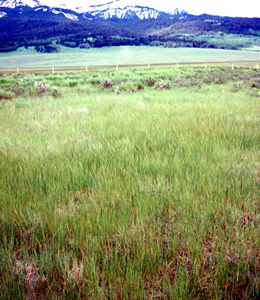Community Field Guide
Scientific Name:
Puccinellia nuttalliana Herbaceous Vegetation
Common Name:
Nuttall's alkali grass Herbaceous Vegetation
Community Description
Summary:
This wetland association is described from a high-elevation (2900 m) park in central Colorado and in southwestern and central Montana, but likely occurs elsewhere across the western and northern Great Plains and the western U.S. and Canada. While the dominant species occurs over a broad geographic range, it has quite specific habitat needs requiring moist soils of intermediate salinity in seasonally wet meadow habitats. Site topography is generally flat with poor drainage. In South Park, Colorado, there is often a small microtopography of hummocks which affects the water relations and therefore species composition. The soils are moist, saline and alkaline, derived from calcareous shales. The snow/rain- and groundwater-saturated soils usually dry out during the growing season. Communities form a ring just above the succulent plant associations associated with playas, salt flats and saline lakes, or may occur as patches along intermittent drainages. They exist in saline soils that range from 0.7-1% total salts. The pH levels are commonly very alkaline. The wetland vegetation is characterized by the dominance of Puccinellia nuttalliana in the graminoid layer. Distichlis spicata or Hordeum jubatum may codominate is some stands. The forb layer is relatively sparse and is often composed of Salicornia rubra or Triglochin maritima. Diagnostic of this herbaceous wetland association is the dominance of Puccinellia nuttalliana.
Environment:
Puccinellia nuttalliana is an uncommon type on the Refuge and globally ranked high for rarity as well. It is sparsely vegetated with Puccinellia nuttalliana (Nuttall’s alkaligrass) approaching monospecific dominance, occurring in small patches as a broken stringer along intermittent drainage’s and on alluvial flats (mostly on the western fringe of Refuge). In some cases on the Refuge Puccinellia nuttalliana constitutes the vegetation band closest to the incised channel on a floodplain position with silty loam alluvial soils. Salt efflorescence was not observed but this community is known to occur on salt-affected soils that have a slightly wetter, temporarily inundated, moisture regime. The Puccinellia nuttalliana type has not been formally described from Montana in the classification efforts of Hansen et al. (1995), but probably has been subsumed by these researchers within the Distichlis stricta or Pascopyrum smithii community types. Within the The Nature Conservancy tracking system this community type has been reported only from Colorado as G1?, but Heidel and Cooper (1997) have documented it from western plains of Montana near the Rocky Mountain Front in field reconnaissance, and cited it from the Canadian literature (=Puccinellia airoides, Dodd and Coupland 1966). We have recognized the type by Puccinellia nuttalliana having at least 10 % cover and greater cover than any other forb indicative of yet drier moisture regimes. It usually exists in a complex with Leymus cinereus (=Elymus cinereus) - Puccinellia nuttalliana, Pascopyrum smithii / alluvial flats or Distichlis spicata (=Distichlis stricta var. stricta) and Sarcobatus vermiculatus dominated types. In the vicinity of the Puccinellia nuttalliana sampling sites a comparable landscape position was occupied by what has been described as Pascopyrum smithii - Distichlis spicata (western wheatgrass - inland saltgrass grassland); WY, ND.
Vegetation:
The refuge examples of this type have low diversity and are compositionally very similar to other observed Montana occurrences. Puccinellia nuttalliana dominants at around 40 % canopy cover. Distichlis spicata, Hordeum jubatum (Hordeum brachyantherum), Leymus cinereus, Grindelia squarrosa and Iva axillaris are the only other herbs exhibiting more than trace coverages or that are present with any consistency. Ericameria nauseosa (=Chrysothamnus nauseosus) and Sarcobatus vermiculatus found in trace amounts were the only shrubs noted within the type.
Global Rank: G3? State Rank: S?
Global Rank Comments:
This type occurs over a broad geographic range, but has quite specific habitat needs. The association requires moist soils of intermediate salinity in seasonally wet meadow habitats of South Park, Colorado (Ungar 1974c). Cooper et al. (1999) suggest this type is quite common in the state of Colorado, occurring in a diversity of habitats. Occurrences are primarily small, however, and often impacted by livestock grazing in that state (Sanderson pers. comm. 1997). Stands of this association have been noted by researchers in the eastern (Nebraska) and northern plains regions to Saskatchewan and through the intermountain region to Utah and California (Ungar 1974c). Saline wetlands which support the association have been impacted by water diversion, livestock grazing, and land conversion in many places. Saline wetland associations of the Great Plains are considered especially vulnerable to habitat fragmentation and loss (Gersib and Steinauer 1991).
Community References
Identifier:
CEGL001799
Author:
99-11-16 / S. V. Cooper, MTNHP
Citations:
Bourgeron and Engelking 1994, Cooper et al. 1999, Dodd and Coupland 1966, Driscoll et al. 1984, Gersib and Steinauer 1991, Ungar 1970, Ungar 1972, Ungar 1974c, Young et al. 1986
View Detailed Citation Information | New Community Search | NatureServe Explorer Community Information
This information is from the:
Montana Natural Heritage Program
Montana State Library--Natural Resource Information System
1515 East Sixth Ave., Helena, MT 59620-1800
406 444-3989
mtnhp.org
mtnhp@mt.gov






